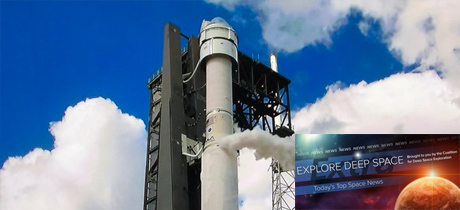In Today’s Deep Space Extra… NASA’s Space Launch System (SLS) passes a critical loads test, as NASA Administrator Jim Bridenstine prepares to offer an update on the Artemis initiative that is to accelerate a human return to the Moon in 2024. Boeing’s CST-100 Starliner orbital flight test launch moves to December 20.
Human Space Exploration
NASA engineers break SLS test tank on purpose to test extreme limits
Coalition Member in the News – Boeing
NASA/Marshall Space Flight Center (12/6): Last Thursday, a test version of the large liquid hydrogen fuel tank for NASA’s Space Launch System (SLS) rocket core stage underwent a structural loads test that pushed it to the limits. Pressurized with liquid nitrogen for the test, the tank withstood more than 260 percent of the expected flight loads over five hours before buckling and rupturing. “This final tank test marks the largest-ever controlled test-to-failure of a NASA rocket stage pressurized tank,” said Mike Nichols, Marshall’s lead test engineer for the tank. “This data will benefit all aerospace companies designing rocket tanks.”
Is Boeing’s mega space rocket back on track?
Coalition Member in the News – Boeing
Politico (12/6): The Boeing Company is moving on from the technical and cost issues involved in the development of the first Space Launch System (SLS) rocket, explains Jennifer Boland-Masterson, the director of Boeing operations at NASA’s Michoud Assembly Facility. “If it was easy, anybody would do it,” she said. “You’d have lots of people building this rocket, but you don’t for a reason.” The powerful rocket will enable NASA and its commercial and international partners to transition human exploration from low Earth orbit to deep space destinations, including the Moon and Mars.
Starliner passes another test, but launch slips one more day
Coalition Members in the News – Boeing, United Launch Alliance
Spacepolicyonline.com (12/6): Following a wet, or fueled, dress rehearsal for the launch of a United Launch Alliance (ULA) Atlas V with Boeing’s orbital flight test CST-100 Starliner, the company announced the uncrewed launch of the capsule to the International Space Station (ISS) will move from December 19 to December 20. The slip was attributed to the out of limit high altitude winds at the Cape Canaveral Air Force Station, Florida, launch site that prompted a day’s delay in a SpaceX Dragon resupply mission from last Wednesday to Thursday and a limited number of personnel to support all of the activity.
In photos: NASA practices emergency astronaut recovery with SpaceX, Boeing
Coalition Member in the News – Boeing
Space.com (12/6): A series of NASA photos illustrate preparations that NASA and its Commercial Crew Program partners, Boeing and SpaceX, have taken to prepare for the recovery of astronauts in the event of an emergency during the launch of the CST-Starliiner and Crew Dragon capsules to the International Space Station (ISS).
Space Science
SpaceX working on fix for Starlink satellites so they don’t disrupt astronomy
SpaceNews.com (12/7): SpaceX will assess a low reflective coating on one of 60 Starlink internet connectivity small satellites slated for launch in late December. Some astronomers have complained the small bright satellites now being launched are disrupting observations. Some 120 have been launched so far, the full constellation will likely number in the thousands.
China’s huge, alien hunting radio telescope is finishing its testing phase
Space.com (12/7): China’s Five-hundred-meter Aperture Spherical Telescope (FAST), the world’s largest, has completed a three year testing phase. FAST has facilitated the study of nearly 100 pulsars and is currently assisting in the search for possible signals from intelligent life beyond the solar system.
Other News
Astroscale pursuing military customers for in-orbit services, debris removal
SpaceNews.com (12/7): A Japanese subsidiary, Denver based Astroscale, U.S. Inc., plans to look to the U.S. military as a potential customer for reducing orbital debris and other on orbit services. The company intends to demonstrate a satellite deorbiting technology next year. Ron Lopez, company president and managing director, discussed Astroscale’s capabilities with the Air Force Space and Missile Systems Center during an industry conference last week.
Falcon 9 cargo mission for NASA demonstrated long-duration coast required by U.S. Air Force
SpaceNews.com (12/7): Last Thursday’s successful SpaceX Falcon 9 launch of a NASA contracted resupply mission to the International Space Station (ISS) included a two hour coast demonstration of the launch vehicle’s second stage plus a post coast 20 second burn. The U.S. Air Force sought the demo to assess the rocket’s ability to place payloads directly in geosynchronous orbit.
Electron launches smallsats in test of rocket reusability
SpaceNews.com (12/6): Rocket Lab launched an upgraded version of the Electron rocket from New Zealand on Friday with a payload of seven small satellites. The launch did not include a first stage recovery, but it did fly several first stage technologies intended to advance future recoveries.
China sends six satellites into orbit with single rocket
Xinhuanet of China (12/7): China managed two launches from the Taiyuan Satellite Launch Center on Saturday, using KZ-1A solid fuel rockets. In all, the two launches placed seven remote sensing satellites in orbit, with the second launch lofting six spacecraft.
Major Space Related Activities for the Week
Major space related activities for the week of December 8-14, 2019
Spacepolicyonline.com (12/8): NASA Administrator Jim Bridenstine plans an update on Artemis Monday morning from NASA’s Michoud Assembly Facility in New Orleans, the facility where the Space Launch System (SLS) core stage was developed and is produced. The SLS is a cornerstone of NASA’s Artemis initiative to carry out an accelerated human return to the surface of the Moon in 2024. In Washington, the U.S. House and Senate are expected to enact legislation this week establishing a Space Force as a sixth branch of the U.S. military. The American Geophysical Union hosts its annual conference in San Francisco this week. The 1st International Orbital Debris Conference meets in the Houston suburb of Sugarland.

